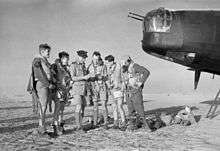No. 150 Squadron RAF
| No. 150 Squadron RAF | |
|---|---|
| Active |
1918–1919 1938–1945 1959–1963 |
| Country | United Kingdom |
| Branch | Royal Air Force |
| Role |
Fighter Bomber Strategic missile |
| Motto(s) |
Greek: Αιει Φθανομεν ("Always Ahead") |
| Engagements |
First World War • Macedonian Front Second World War Cold War |
| Aircraft flown | |
| Bomber |
Fairey Battle Vickers Wellington Avro Lancaster |
| Fighter |
Bristol M.1c Royal Aircraft Factory SE.5a Sopwith Camel |
No. 150 Squadron RAF was an aircraft squadron of the Royal Air Force during both World War I and World War II.[1][2] In the early 1960s it was briefly reformed as a Strategic Missile squadron operating the Thor IRBM.
World War I
The squadron was founded in April 1918 at Salonika, Greece with elements from both No. 17 Squadron RAF and No. 47 Squadron RAF. It was equipped with Bristol M.1c, Royal Aircraft Factory SE.5a, and Sopwith Camel aircraft during its World War I service. Ten aces served with the unit, including such notables as Gerald Gordon Bell, Charles D. B. Green, Douglas Arthur Davies, Acheson Goulding, Frederick Dudley Travers, Franklin Saunders, Arthur Jarvis, George Gardiner, and Leslie Hamilton.[2]
World War II
It reformed in 1938 equipped with Fairey Battle light bombers, taking them to France as part of the Advanced Air Striking Force in September 1939. It received heavy losses in attempting to oppose the German invasion of France in May 1940, being evacuated back to England by 20 May.[3][4]

It re-equipped with Vickers Wellingtons from in October 1940,[4] operating from RAF Newton.[1] It moved to the Mediterranean Theatre in December 1942, flying its Wellingtons from Blida in Algeria against targets in Tunisia and Sardinia. It moved to Tunisia in May 1943, and to bases in Italy in December, disbanding in October 1944.[3][4]
It reformed again in November 1944 at RAF Fiskerton in Lincolnshire, equipped with the Avro Lancaster heavy bomber. It soon moved to RAF Hemswell, flying 827 operational sorties and dropping 3,827 tons of bombs while losing eight aircraft and 40 aircrew. It was involved in Operation Manna to drop food supplies to starving Dutch civilians at the end of the War in Europe, and after the end of hostilities, was used to repatriate POWs from Europe back to the United Kingdom. It was disbanded again on 7 November 1945.[3][4]
Cold war
The squadron was reformed - as No. 150 (SM) Squadron - on 8 January 1959 as one of 20 Strategic Missile (SM) squadrons associated with Project Emily. The squadron was equipped with three Thor Intermediate range ballistic missiles, and based at RAF Carnaby in Yorkshire. In October 1962, during the Cuban Missile Crisis, the squadron was kept at full readiness, with the missiles aimed at strategic targets in the USSR. The squadron was disbanded on 9 April 1963, as the Thor Program in Britain was brought to a close.
Notable pilots
References
- Notes
- Bibliography
- Gunston, Bill (1978). The Illustrated Encyclopedia of Combat Aircraft of World War II. Salamander Books Ltd. ISBN 0-89673-000-X.
- Melinsky, M. A. H (March 1971). "Your Questions Answered; No 150 Squadron RAF". Air Pictorial.
External links
| Wikimedia Commons has media related to No. 150 Squadron RAF. |
- "No. 150 Squadron, 10 May to 30 June 1940". Traces of World War 2. 2008.
- Rickard, J. (2008). "No. 150 Squadron (RAF): Second World War". Military History Encyclopedia on the Web.
- Barrass, M. B. (2016). "No. 146-150 Squadron Histories". Air of Authority – A History of RAF Organisation.